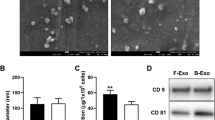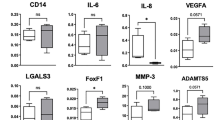Abstract
Acidic conditions are present in degenerated intervertebral discs and are believed to be responsible for matrix breakdown. Acid-sensing ion channel 1a (ASIC1a) is expressed in endplate chondrocytes, and its activation is associated with endplate chondrocyte apoptosis. However, the precise role of ASIC1a in regulating the matrix metabolic activity of endplate chondrocytes in response to extracellular acid remains poorly understood. Aggrecan (ACAN), type II collagen (Col2a1), and matrix metalloproteinase (MMP) expressions were determined using reverse transcription (RT)-PCR and Western blot. ASIC1a was knocked down by transfecting endplate chondrocytes with ASIC1a siRNA. MMP activity and NF-κB transcriptional activity were measured. NF-κB transcriptional activity was assessed by examining cytosolic phosphorylated IκBα and nuclear phosphorylated p65 levels. Extracellular acidic solution (pH 6.0) resulted in a decrease in ACAN and Co12a1 expressions and an increase in MMP-1, MMP-9, and MMP-13 expressions, as well as in MMP activity; while ASIC1a siRNA blocked these effects. In addition, acid-induced increase in cytosolic levels of phosphorylated IκBα and nuclear levels of phosphorylated p65 in endplate chondrocytes were inhibited by ASIC1a siRNA. ASIC1a is involved in matrix metabolism of endplate chondrocytes under extracellular acidic conditions via NF-κB transcriptional activity.




Similar content being viewed by others
References
Bibby SR, Jones DA, Ripley RM et al (2005) Metabolism of the intervertebral disc: effects of low levels of oxygen, glucose, and pH on rates of energy metabolism of bovine nucleus pulposus cells. Spine (Phila Pa 1976) 30:487–496
Bibby SR, Urban JP (2004) Effect of nutrient deprivation on the viability of intervertebral disc cells. Eur Spine J 13:695–701
Cao E, Liao M, Cheng Y et al (2013) TRPV1 structures in distinct conformations reveal activation mechanisms. Nature 504:113–118
Grunhagen T, Wilde G, Soukane DM et al (2006) Nutrient supply and intervertebral disc metabolism. J Bone Joint Surg Am 88(Suppl 2):30–35
Herrero CF, Garcia SB, Garcia LV et al. (2014) Endplates changes related to age and vertebral segment Biomed Res Int 2014:545017
Ishihara H, Urban JP (1999) Effects of low oxygen concentrations and metabolic inhibitors on proteoglycan and protein synthesis rates in the intervertebral disc. J Orthop Res 17:829–835
Jackson AR, Huang CY, Gu WY (2011) Effect of endplate calcification and mechanical deformation on the distribution of glucose in intervertebral disc: a 3D finite element study. Comput Methods Biomech Biomed Engin 14:195–204
Justus CR, Dong L, Yang LV (2013) Acidic tumor microenvironment and pH-sensing G protein-coupled receptors. Front Physiol 4:354
Ledoux AC, Perkins ND (2014) NF-kappaB and the cell cycle. Biochem Soc Trans 42:76–81
Li X, Wu FR, Xu RS et al (2014) Acid-sensing ion channel 1a-mediated calcium influx regulates apoptosis of endplate chondrocytes in intervertebral discs. Expert Opin Ther Targets 18:1–14
Luqman S, Pezzuto JM (2010) NFkappaB: a promising target for natural products in cancer chemoprevention. Phytother Res 24:949–963
Ma B, Zhong L, van Blitterswijk CA et al (2013) T cell factor 4 is a pro-catabolic and apoptotic factor in human articular chondrocytes by potentiating nuclear factor kappaB signaling. J Biol Chem 288:17552–17558
Maidhof R, Alipui DO, Rafiuddin A et al (2012) Emerging trends in biological therapy for intervertebral disc degeneration. Discov Med 14:401–411
Malandrino A, Lacroix D, Hellmich C et al (2014) The role of endplate poromechanical properties on the nutrient availability in the intervertebral disc. Osteoarthr Cart 22:1053–1060
Razaq S, Wilkins RJ, Urban JP (2003) The effect of extracellular pH on matrix turnover by cells of the bovine nucleus pulposus. Eur Spine J 12:341–349
Roberts S, Caterson B, Menage J et al (2000) Matrix metalloproteinases and aggrecanase: their role in disorders of the human intervertebral disc. Spine (Phila Pa 1976) 25:3005–3013
Sakai D, Grad S (2014) Advancing the cellular and molecular therapy for intervertebral disc disease Adv Drug Deliv Rev
Su SC, Tanimoto K, Tanne Y et al (2014) Celecoxib exerts protective effects on extracellular matrix metabolism of mandibular condylar chondrocytes under excessive mechanical stress. Osteoarthr Cart 22:845–851
Urban JP, Smith S, Fairbank JC (2004) Nutrition of the intervertebral disc. Spine (Phila Pa 1976) 29:2700–2709
Vincenti MP, Brinckerhoff CE (2002) Transcriptional regulation of collagenase (MMP-1, MMP-13) genes in arthritis: integration of complex signaling pathways for the recruitment of gene-specific transcription factors. Arthritis Res 4:157–164
Waldmann R, Champigny G, Bassilana F et al (1997) A proton-gated cation channel involved in acid-sensing. Nature 386:173–177
Wang Y, Battie MC, Boyd SK et al (2011) The osseous endplates in lumbar vertebrae: thickness, bone mineral density and their associations with age and disk degeneration. Bone 48:804–809
Xiong ZG, Zhu XM, Chu XP et al (2004) Neuroprotection in ischemia: blocking calcium-permeable acid-sensing ion channels. Cell 118:687–698
Yuan FL, Chen FH, Lu WG et al (2010) Acid-sensing ion channel 1a mediates acid-induced increases in intracellular calcium in rat articular chondrocytes. Mol Cell Biochem 340:153–159
Yuan FL, Wang HR, Zhao MD et al (2014) Ovarian cancer G protein-coupled receptor 1 is involved in acid-induced apoptosis of endplate chondrocytes in intervertebral discs. J Bone Miner Res 29:67–77
Acknowledgments
This work was supported by the Natural Science Foundation of China (81270011; 81472125) and the Natural Science Foundation of Jiangsu Province (Grants BK20151114) and Foundation of Traditional Chinese Medicine of Jiangsu Province (YB201578).
Conflict of interest
The authors declare no conflicts of interest.
Author information
Authors and Affiliations
Corresponding authors
Additional information
Xia Li and Ming-Dong Zhao contributed equally to this work.
Electronic supplementary material
Below is the link to the electronic supplementary material.
Figure S 1
(DOC 603 kb)
Rights and permissions
About this article
Cite this article
Yuan, FL., Zhao, MD., Jiang, DL. et al. Involvement of acid-sensing ion channel 1a in matrix metabolism of endplate chondrocytes under extracellular acidic conditions through NF-κB transcriptional activity. Cell Stress and Chaperones 21, 97–104 (2016). https://doi.org/10.1007/s12192-015-0643-7
Received:
Revised:
Accepted:
Published:
Issue Date:
DOI: https://doi.org/10.1007/s12192-015-0643-7




